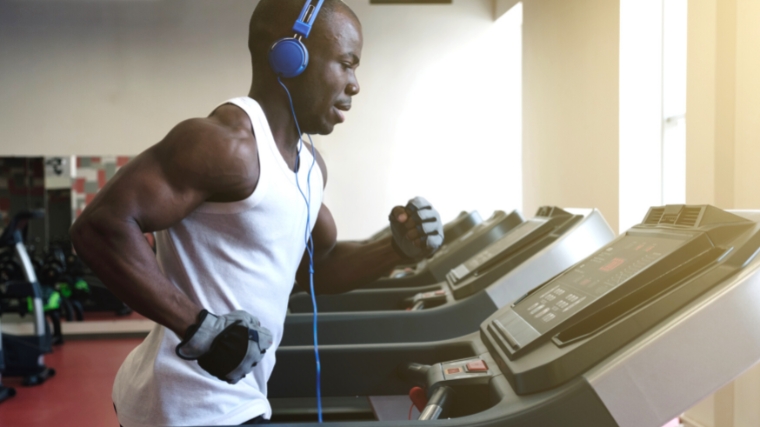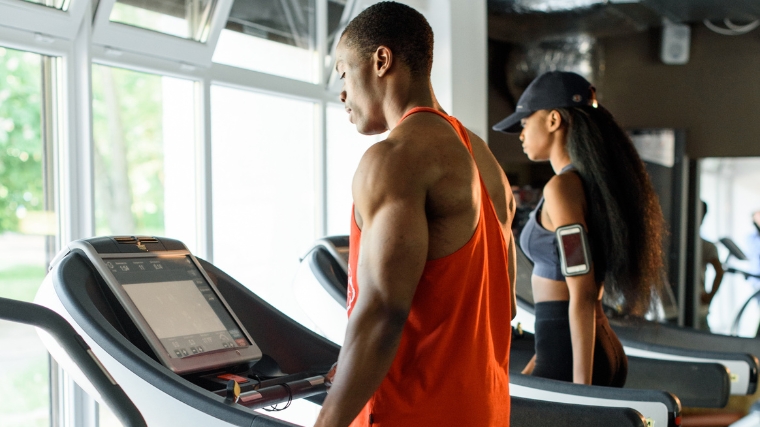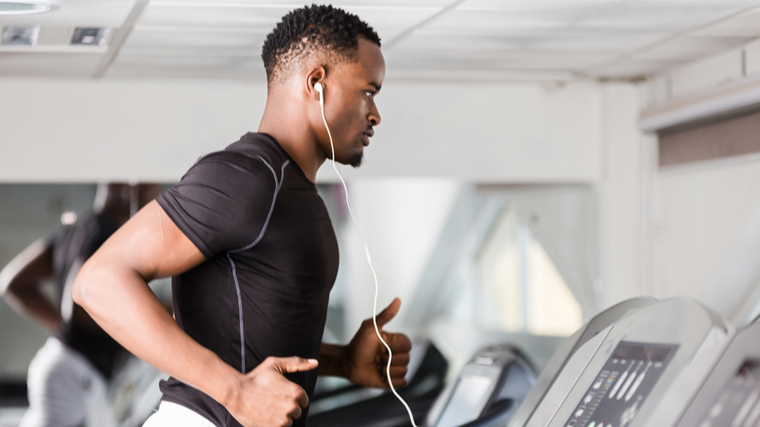The treadmill is about as recognizable as the dumbbell when you enter the average commercial gym. Early on in your fitness journey, you may have even started your workouts on the treadmill before “graduating” to free weights or machines. That said, it might be time to get back to basics.
Running, walking, and endurance enthusiasts are instantly drawn to the treadmill for obvious reasons: When it comes to getting some steps, breaking a sweat, or sprinting for your maximum heart rate, there’s nothing better.

Although it may seem like a low-value piece of equipment for the iron-minded weightlifter, even a budget treadmill offers a lot more than what you see at a first glance. Given a fair shake, the treadmill can actually be a very complimentary — if not supplementary part — of your fitness routine. Here are 7 treadmill benefits you need to know about.
Benefits of Treadmills
- A Great Warm-Up
- Cardiovascular Health
- High-Intensity Interval Training
- Scalable Intensity
- They’re Space Efficient
- They’re Easy to Use
- They’re Everywhere
A Great Warm-Up
The treadmill is a huge asset when it comes to improving the quality of your overall workout, whether you’re using it to jumpstart your warm-up routine, for some vigorous incline hiking, or even as a way of getting your head in the game for the gym. Here’s how the treadmill benefits your warm-up:
Raise Your Core Temperature
You don’t have to be training on a chilly day to benefit from a good general warm-up. You can hop on the treadmill to get your blood flowing and raise your core temperature. The combination of a general warm-up followed by your workout-specific warm-up may work even better than doing only one of the two.
One study combining a 20 minute general warm-up with a specific warm-up seemed to provide improved 1-repetition maximum lower-body strength than warming up with just strength training. (1) On particularly important sessions, try adding in power walk or light jog to get some blood pumping before any barbell exercise. From here, you can start your specific or dynamic warm-up and you’re in business for the day.
Incline Walk or Hike
The incline walk offers some distinct benefits from a general warm-up just designed to break a sweat. Cranking your treadmill up in grade and walking at a brisk pace can help you specifically warm up your hips. The incline and pace will encourage you to take deeper strides, emphasizing your glutes.

[Read More: The Best Foods for Energy Before, During, and After Your Workouts]
After a long day of sitting, standing, or generally sedentary work life, an incline walk can be a perfect warm-up to make sure you’re moving well before loading up.
Psychological Preparation
The treadmill can also be the perfect place to compartmentalize your day. Keeping your focus on the task at hand in the gym can be an important piece of the puzzle. Work stress, family responsibilities, or other distractions can often linger on your mind even when you’re mid-workout.
You can use a few minutes on the treadmill to center yourself and mentally shift into “training mode.” The solitude and rhythm of a treadmill might be exactly what you need to upgrade your mindset before you start training.
Cardiovascular Health
If there’s a benefit of the treadmill that truly stands out, it’s cardiovascular health. While you may train for a wide variety of reasons with varying priorities, the overarching rationale for exercise is almost always to improve your health in some way. Weight lifting covers some of the ground here, but there’s no escaping the specific benefits to your cardiovascular system by using the treadmill.
Whether you use low-intensity steady state or some moderate-intensity jogging, the treadmill can offer up some significant improvements for your cardiovascular health. Even low-intensity treadmill activities like walking have been shown to have great protective benefits for your risk of cardiovascular disease. (2)
High-Intensity Interval Training
High-intensity interval training (HIIT) is a performance-oriented style of cardio that the treadmill accommodates exceptionally well. It involves quick bursts of extreme effort — think sprinting as hard as you can — followed by a downshift into a low-intensity “recovery” phase.
The treadmill is one of the best types of equipment for HIIT. Most treadmills have pre-built HIIT protocols in their interface, gradually increasing and decreasing in speed at the perfect cadence.

[Read More: Nutrition for Athletes — How to Eat for Muscle and Performance]
High-intensity interval training has been shown to offer up significant health benefits that overlap with what you can expect from moderate-intensity steady state work. By comparison, however, your treadmill HIIT workouts will require significantly less time investment to achieve these results. (3)
Scalable Intensity
The treadmill is accessible to everyone, regardless of your fitness level. For example, it can be a reliable sanctuary for you to accumulate your step count goal for the day. On the other hand, it can be a performance tool for your sprint training, a part of endurance race preparation, or anything in between. Whether you’re starting day one of your fitness journey or a seasoned competitor, the treadmill can be scaled to meet you where you’re at.
They’re Space Efficient
It may be large, but for practical purposes, the treadmill is an extremely space-efficient piece of equipment. It can not only transform miles of track into a stationary location but it can be repurposed for core work or even walking lunges, too.
The average treadmill measures around three and a half feet wide and a little over six or seven feet long — snug enough to easily accommodate any home training space. There’s a reason why commercial gyms line entire rows of cardio with treadmills; they’re economical and versatile. If you can’t get your cardio in outside but have a corner of a room available, a treadmill at home can come in clutch.
They’re Easy to Use
Most treadmills are about as easy as hitting the “quick start” button. That said, treadmills are individually programmed with a ton of different training options. From hills, intervals, or simply walking, there’s likely an option to fit your needs.

Beyond that, you have the option to tailor your workout to whatever you’d prefer by simply playing with the speed and incline on your own. There’s no complex learning curve, hit one button and get moving.
They’re Everywhere
One of the biggest benefits of considering treadmill work is that they are almost everywhere. If you’re building your own body conditioning workout, you need to consider the tools at your disposal — you may not have reliable access to a stair climber, ski-erg, and so on.
On the other hand, you’d be hard-pressed to find a public gym that doesn’t have at least one treadmill. This makes the treadmill a cornerstone of your warm-up and cardiovascular training; it’s always there when you need it.
Who Should Do Treadmill Work
Treadmill work is extremely beneficial for strength athletes, bodybuilders, and, frankly, just about everyone else. Here’s how.
Strength Athletes
Strength athletes stand out as candidates for treadmill workouts because of the nature of heavy barbell-based workouts. When you’re training for maximal force output, there aren’t a ton of repetitions, but there is a ton of downtime.
This results in a low average heart rate, which may limit the cardiovascular benefits of your workout — even if those benefits are tangential to your primary goal of increasing strength.

[Read More: The 10 Best Protein Powders for Muscle Gain (2023 Update)]
Integrating some treadmill walking can be a smart way to increase cardiovascular health, improve recovery between sets, but also keep things low enough intensity to not pile onto the hard training you’re already doing under the barbell.
Bodybuilders
Bodybuilders are precision athletes. From chiseling out extremely specific physiques to meticulously calculating nutritional intake, bodybuilders are all about the numbers. High volumes of cardio are all but required for the bodybuilder trying to lean out for a competition as well.
With that in mind, you’re going to need a form of cardio that is easy to measure, easy to complete, and easy to maintain. Treadmill walking fits the bill perfectly here — simply step your way to a stage-worthy physique.
General Populations
Special considerations for bodybuilders and strength athletes aside, the utility of treadmills doesn’t just apply to these strategic situations. Everyone can improve their cardiovascular base, become more active, and improve their workout focus by utilizing the treadmill. Regardless of your fitness goals, the treadmill can help boost your results in the gym.
When to Use the Treadmill
Knowing when to program the treadmill can help you establish it as a routine. Thankfully, treadmill work can be performed before or after you lift, or even as its own standalone day.
Before Lifting
Depending on what your training goal for the day is, you can easily insert 20-30 minutes of low intensity treadmill walking. This prolonged warm-up can accumulate the steps you need for some good general health outcomes and also keep you fresh enough to complete a hard lift after the fact.

Depending on your training goals, you can also prioritize harder treadmill training before you lift just as easily. If you’re a concurrent trainer looking to prioritize cardiovascular training while still putting on some size, hitting your treadmill work before a lift is equally as beneficial.
One caveat here — you may not want to spend a lot of time on the treadmill prior to training your legs with weights, particularly if you’re working on a high incline. Save the treadmill for after those squats.
After Lifting
A great way to cool down before heading home is to use the treadmill. Similar to a warm-up, some moderate intensity walking can help bring down your heart rate, intensity, and let you relax back into the rest of your day.
Likewise, it can be the perfect time to burn off any lingering energy or shoot for higher-intensity training. Knocking out some intervals to round out your lift is a great option too, sweat it out and hit the showers.
Standalone Workouts
Unless you plan to lift every single day, you also have the option to compartmentalize your weight room and treadmill work. Place your cardio session on its own day and you can walk in with a completely full gas tank.

Instead of potentially managing energy for both cardio and lifting, smash the treadmill with all you’ve got. A good 30-60 minutes followed by some core work or the sauna is a pretty solid active recovery regimen.
Treat Yourself to the Treadmill
Treadmills might be the first purchase most gyms make after signing their lease, and for good reason. Everyone can benefit from a healthier set of lungs, but treadmills can also be used to set the tone for the rest of your workout.
To that end, a treadmill can be leveraged to compliment some pretty serious competitive goals. From maximal strength to maximal muscle, the treadmill fits in as well here as it does for your general health. Whether pre, post, or as a standalone workout, it’s time to treat yourself to the treadmill.
References
- Abad, C. C., Prado, M. L., Ugrinowitsch, C., Tricoli, V., & Barroso, R. (2011). Combination of general and specific warm-ups improves leg-press one repetition maximum compared with specific warm-up in trained individuals. Journal of strength and conditioning research, 25(8), 2242–2245.
- Boone-Heinonen, J., Evenson, K. R., Taber, D. R., & Gordon-Larsen, P. (2009). Walking for prevention of cardiovascular disease in men and women: a systematic review of observational studies. Obesity reviews : an official journal of the International Association for the Study of Obesity, 10(2), 204–217.
- Atakan, M. M., Li, Y., Koşar, Ş. N., Turnagöl, H. H., & Yan, X. (2021). Evidence-Based Effects of High-Intensity Interval Training on Exercise Capacity and Health: A Review with Historical Perspective. International journal of environmental research and public health, 18(13), 7201.
Featured Image: SOK Studio / Shutterstock